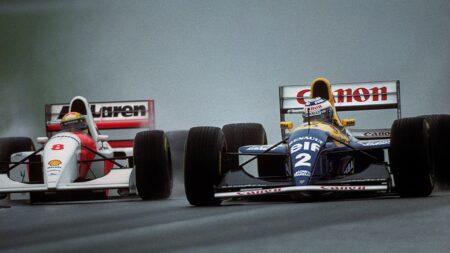A second consecutive, and particularly brilliant, victory from Max Verstappen around Baku last weekend is inviting comparisons with Ayrton Senna‘s 1993 season. In each case, the recognised best driver was not in the best car and not really in title contention but was capable of slipping through the tiniest slit of an opportunity to conjure victories. These against-the-odds performances may even add more to the legendary status of such drivers than their more successful seasons.
But invariably, it’s rarely as simple as the romantic notion of the genius driver more than overcoming the performance deficit of his car through sheer virtuosity. It’s usually more that their extreme talent ensures they are ready to capitalise when the overall faster car has been compromised, that every time such an opportunity presents itself, they are there to pounce. Always them, every time.
There is no question that the 1993 Williams-Renault was a faster car than the McLaren-Ford of the same year, just as there is no question that the 2025 McLaren is a faster car than the current Red Bull. But that is as measured over the global range of circuits comprising the championship. It can occasionally be that the overall fastest car is not actually the fastest on a given day. But the status sticks, the general assumption is that the fastest car is always the fastest car and any time therefore it is beaten, it must be because of driving genius in the slower car. That’s usually a flawed assumption.
We need to be very careful with words here. The genius level driver is still the genius level driver even on the days when the prime reason they’ve won is because their car on that day – regardless of it overall being a slower car than the best – is actually fully competitive. But the dominant narrative – only partially true – will inevitably be that it’s all down to the genius. If we think back to one of the greatest demonstrations of driving genius of all time – Ayrton Senna, Donington ’93 – he needed all that supreme ability to do what he did that day. But in those wet conditions, the high downforce McLaren MP4/8 was actually a very competitive car. Its power deficit to the all-round superior Williams FW15C didn’t count for much. Furthermore, the conditions on that day exposed a little glitch in the Williams software which tended to lock up the rear wheels on downshifts at low speeds. It was also suffering from a dragging clutch, exacerbating the problem. So Alain Prost was unable to use late braking in defence. It later emerged that the tyre pressures were too high because of a measuring equipment fault.





